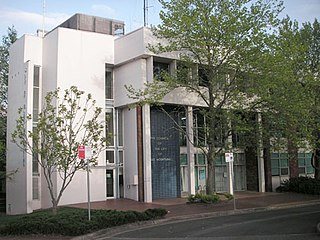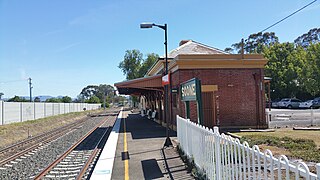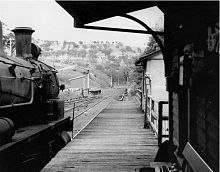
The Upper Hunter Shire is a local government area in the Upper Hunter Valley of New South Wales, Australia. The Shire was formed in May 2004 from the Scone Shire and parts of Murrurundi and Merriwa shires.

Liverpool Plains Shire is a local government area located in the North West Slopes region of New South Wales, Australia. The Shire was formed on 17 March 2004 by the amalgamation of Quirindi Shire with parts of Parry, Murrurundi and Gunnedah shires.

The Bethungra Spiral is a heritage-listed rail spiral near Bethungra, between Junee and Cootamundra, carrying the northbound track of the Melbourne → Sydney railway line.

The City of Blue Mountains is a local government area of New South Wales, Australia, governed by the Blue Mountains City Council. The city is located in the Blue Mountains, on the Great Dividing Range at the far western fringe of the Greater Sydney area. Major settlements include, Katoomba, Lawson, Springwood and Blaxland.

Quirindi is a small town on the North West Slopes region of New South Wales, Australia, in Liverpool Plains Shire. At the 2021 census, Quirindi had a population of 2,602. It is the nearest link to Gunnedah to the northwest and Tamworth to the north. The local economy is based on agriculture, with broadacre farming dominant on the black soil plains to the west and livestock grazing in the hilly eastern part of the district.

Scone railway station is a heritage-listed railway station located on the Main Northern line in Scone, in the Upper Hunter Shire local government area of New South Wales, Australia. The station serves the town of Scone and opened on 17 April 1871. The property was added to the New South Wales State Heritage Register on 2 April 1999.

The Cougal Spiral is a heritage-listed single track railway tunnel and spiral feature of the North Coast railway line in Australia that connects New South Wales with Queensland under the Border Ranges near Richmond Gap in the Kyogle Council local government area of New South Wales, Australia. It was built during 1930. It is also known as the Border Loop railway formation and landscape, Cougal To Border Loop and Railway Spiral and Landscape. The property was added to the New South Wales State Heritage Register on 2 April 1999.

Victoria Street railway station is a heritage-listed railway station located on the Main Northern line in New South Wales, Australia. It serves the Victoria Street area of East Maitland. It was added to the New South Wales State Heritage Register on 2 April 1999.

Branxton railway station is a heritage-listed railway station located on the Main Northern line in New South Wales, Australia. It serves the town of Branxton opening on 24 March 1862. It was added to the New South Wales State Heritage Register on 2 April 1999.

Wagga Wagga railway station is a railway station open for passenger services on the Main Southern line connecting Sydney and Melbourne. It has been heritage-listed, especially on account of its historical and architectural significance. A museum is on the premises. As of 2021, two daily passenger trains in each direction served the City of Wagga Wagga.

The Grafton Bridge is a heritage-listed bascule truss bridge that carries Bent Street and North Coast railway line across the Clarence River in Grafton, New South Wales, Australia. The bridge links the Grafton central business district with South Grafton, and was added to the New South Wales State Heritage Register on 2 April 1999.

The Lithgow Zig Zag is a heritage-listed former zig zag railway line built near Lithgow on the Great Western Line of New South Wales in Australia. The zig zag line operated between 1869 and 1910, to overcome an otherwise insurmountable climb and descent on the western side of the Blue Mountains. It was designed by John Whitton and built from 1863 to 1869 by Patrick Higgins as contractor. It is also known as the Great Zig Zag Railway and Reserves and Zig Zag Railway. The property is owned by Department of Planning and Infrastructure. It was added to the New South Wales State Heritage Register on 2 April 1999.

Culcairn railway station is a heritage-listed railway station located on the Main Southern line in New South Wales, Australia. It serves the town of Culcairn. It was added to the New South Wales State Heritage Register on 2 April 1999.

Cootamundra railway station is located on the Main Southern line in New South Wales, Australia. It serves the town of Cootamundra. The property was added to the New South Wales State Heritage Register on 2 April 1999.

Ardglen is a village on the Main North railway line and close to the New England Highway on the North West Slopes region of New South Wales, Australia.

Tamworth railway station is a heritage-listed railway station located on the Main Northern line in Tamworth, in the Tamworth Regional Council local government area of New South Wales, Australia. It serves the city of Tamworth, and opened on 9 January 1882 when the line was extended from West Tamworth to Kootingal. It is also known as the Tamworth Railway Station, yard group and movable relics. The property was added to the New South Wales State Heritage Register on 2 April 1999.

Murrurundi railway station is a heritage-listed railway station located on the Main Northern line in Murrurundi in the Upper Hunter Shire local government area of New South Wales, Australia. It was built between 1872 and 1917. It is also known as Murrurundi Railway Station group. The station serves the town of Murrurundi and opened on 4 April 1872. The station served as the terminus of the line until it was extended to Quirindi on 13 August 1877. The station was added to the New South Wales State Heritage Register on 2 April 1999.

Willow Tree railway station is located on the Main Northern line in New South Wales, Australia. It serves the village of Willow Tree, opening on 13 August 1877 as Warrah when the line was extended from Murrururundi to Quirindi. It was renamed Willow Tree in 1879.

Quirindi railway station is a heritage-listed railway station located on the Main Northern line in Quirindi in the Liverpool Plains Shire local government area of New South Wales, Australia. The station serves the town of Quirindi and opened on 13 August 1877 when the line was extended from Murrurundi. It was the terminus of the line until it was extended to West Tamworth on 14 October 1878. It is also known as Quirindi Railway Station group. The railway station was added to the New South Wales State Heritage Register on 2 April 1999.

The Rydal rail underbridges are a series of heritage-listed railway underbridges and viaducts that carry the Main Western line over Solitary Creek at Rydal, in the City of Lithgow local government area of New South Wales, Australia. The property is owned by Transport Asset Holding Entity, an agency of the Government of New South Wales. It was added to the New South Wales State Heritage Register on 2 April 1999.





















